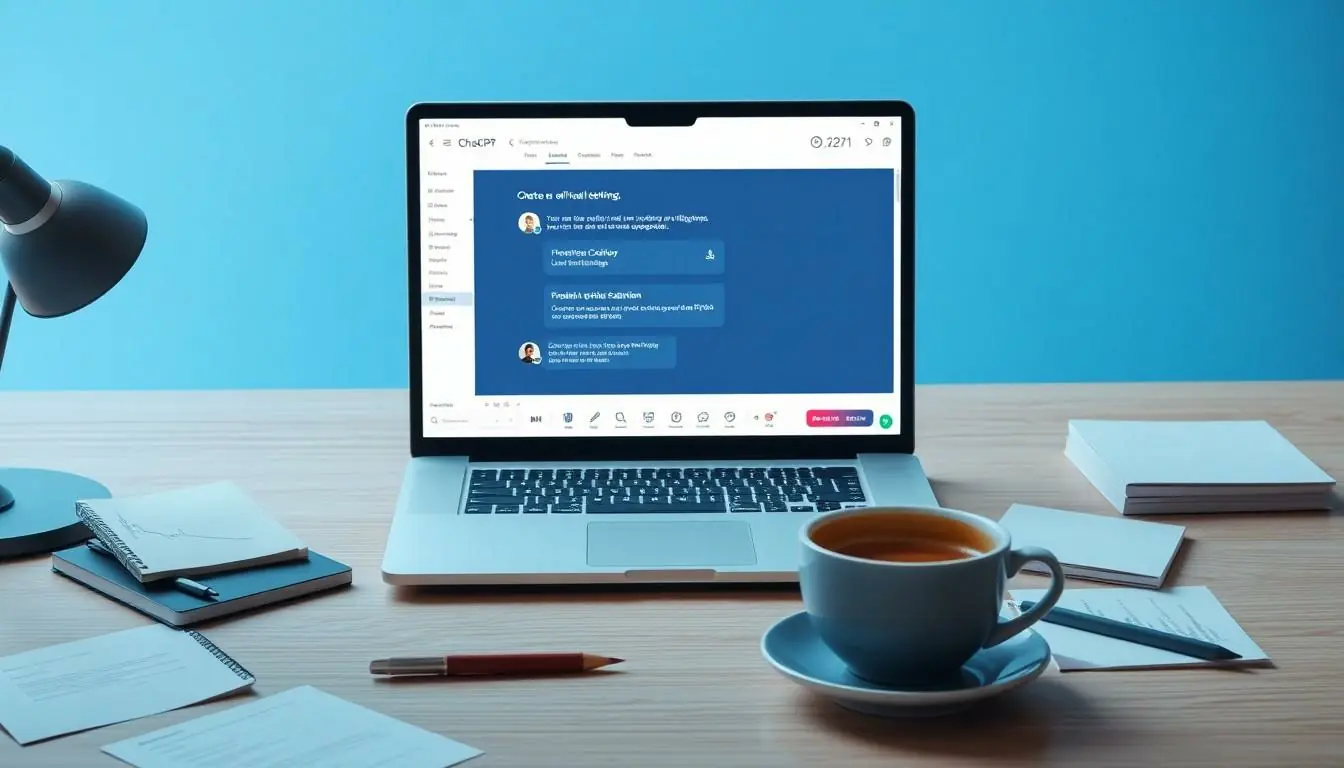Table of Contents
ToggleIn a world where technology evolves faster than a cat meme goes viral, ChatGPT has emerged as a game-changer in the realm of artificial intelligence. But just how fresh is this digital conversationalist? With its roots planted firmly in recent advancements, ChatGPT is not just a relic of the past; it’s the life of the AI party, ready to engage, entertain, and educate.
Imagine having a witty friend who’s always up-to-date with the latest trends and facts. That’s ChatGPT for you! Its development is a testament to the rapid strides in AI, making it a tool that feels both cutting-edge and approachable. So, let’s dive into the timeline of ChatGPT’s evolution and discover just how recent this remarkable technology really is.
Overview of ChatGPT
ChatGPT represents a significant advancement in artificial intelligence, showcasing various capabilities. Its development stems from the OpenAI organization, which focuses on creating state-of-the-art AI systems. With ChatGPT, users experience high-quality interactions, including engaging conversations and insightful responses.
Launched in November 2022, ChatGPT quickly gained popularity due to its impressive performance. Updates and improvements continue to enhance its functionalities, demonstrating a commitment to innovation. Recent iterations have introduced features like better context understanding and more nuanced dialogue.
Available across multiple platforms, ChatGPT serves diverse applications. Users utilize it for tasks such as content creation, tutoring, and problem-solving. Its versatility makes it a valuable tool in various fields, from education to business.
Ongoing research and development ensure that ChatGPT stays relevant. Each new update incorporates user feedback, fostering a responsive evolution. This commitment to improvement solidifies its position as a contemporary AI solution.
Several milestones mark ChatGPT’s timeline, showcasing its rapid growth. The transition from GPT-3 to GPT-4 highlighted improvements in comprehension and generation. Comparatively, this evolution illustrates a significant leap forward in AI capabilities.
As an active part of ongoing advances in artificial intelligence, ChatGPT reflects the latest innovations. Its capacity for learning and adapting aligns with the fast-paced nature of technological progress. Many users find it a reliable companion in their daily tasks, emphasizing its relevance in today’s digital landscape.
Development Timeline

The development of ChatGPT represents a rapid evolution in artificial intelligence. It reflects significant advancements in natural language processing since its inception.
Key Milestones
OpenAI launched ChatGPT in November 2022 as part of the GPT-3.5 series. This release marked a substantial step forward in interactive AI technology. The transition to GPT-4 took place in March 2023, introducing enhanced capabilities in comprehension. Further enhancements included improvements in handling complex queries and maintaining context over longer conversations. By June 2023, more iterations aimed at refining user engagement were implemented, demonstrating OpenAI’s commitment to continuous innovation.
Major Updates
Regular updates ensure that ChatGPT remains at the forefront of AI technology. One prominent update in February 2023 enhanced its contextual understanding, resulting in more coherent dialogues. Summer 2023 brought additional features, such as multimodal capabilities, allowing it to process both text and images. User feedback played an essential role in these revisions, with OpenAI actively incorporating suggestions to improve functionality. As of October 2023, ChatGPT continues to receive updates that fine-tune its performance, keeping it relevant and effective in diverse applications.
Current Capabilities
ChatGPT stands out for its advanced functionalities and ongoing enhancements, making it a contemporary tool in the AI landscape.
Features of the Latest Version
Multimodal capabilities enable ChatGPT to process both text and images. This flexibility opens new avenues for interactive applications. Enhanced context understanding allows for deeper engagement in conversations, producing more relevant responses. New updates improve creativity in content creation, supporting users in various tasks. The version released in October 2023 showcases refined dialogue skills, offering users a more nuanced interaction experience. Additionally, the AI demonstrates impressive problem-solving abilities, enhancing its utility in educational and professional settings. Overall, these features reflect continuous advancements that keep the platform competitive.
Limitations and Challenges
Despite its strengths, ChatGPT faces challenges that affect its performance. Conversations with insufficient context can lead to relevant issues in responses. Ambiguity in user queries often results in misinterpretations, highlighting a need for clear communication. While updates improve capabilities, the AI still struggles with real-world knowledge that evolves rapidly. Ensuring accurate information remains a priority, yet it occasionally relies on outdated data. Users might notice occasional inconsistencies in tone or style, which disrupt the overall flow of interaction. Addressing these limitations is crucial for enhancing user satisfaction and maintaining ChatGPT’s relevance in evolving digital dialogues.
Impact on Various Industries
ChatGPT significantly influences various sectors by providing innovative solutions and addressing contemporary challenges. Its integration into different fields showcases its versatility and effectiveness.
Education
Educators leverage ChatGPT to enhance learning experiences by providing personalized tutoring. It assists students with immediate feedback on assignments and helps clarify complex concepts. Instructors can use ChatGPT to generate lesson plans or engage students in interactive discussions. Its multimodal capabilities support a diverse range of materials, including texts and visuals. Overall, ChatGPT fosters an environment that promotes independent learning and critical thinking, making it an indispensable resource in modern education.
Customer Service
Many businesses utilize ChatGPT to improve customer service interactions. It can handle multiple inquiries simultaneously, ensuring quicker response times. With enhanced understanding of context, ChatGPT addresses customer needs efficiently, providing accurate information and solutions. Implementing this technology reduces wait times, leading to higher satisfaction rates. Additionally, it operates 24/7, allowing businesses to offer consistent support at all hours. By streamlining customer interactions, ChatGPT contributes to a more effective and responsive customer service experience.
Future Prospects
ChatGPT continues to evolve, shaping the landscape of AI technology. The development trajectory promises even greater advancements and capabilities.
Upcoming Developments
Upcoming updates will enhance ChatGPT’s functionalities, focusing on improving contextual understanding and reducing ambiguity in responses. OpenAI aims to refine chat dialogues through user feedback, increasing overall accuracy and responsiveness. Innovations in natural language processing may emerge, enabling more nuanced interactions. Plans for further integration of multimodal features suggest increased versatility, allowing for richer user experiences. Continuous iteration ensures that ChatGPT not only keeps pace with advancements but also sets new benchmarks for AI applications.
Trends in AI Interaction
Trends in AI interaction indicate a shift towards more personalized experiences driven by data analytics. Users increasingly expect adaptive learning models that cater to individual preferences, and ChatGPT is positioned to meet that demand. Natural language understanding improvements lead to smoother, more human-like conversations. Integration with various platforms allows seamless communication, enhancing accessibility. The rise of AI in workplaces signals a growing reliance on tools like ChatGPT for increased productivity and efficiency. As these trends develop, they will shape future interactions with AI, solidifying its role in everyday tasks.
ChatGPT stands as a testament to the rapid advancements in artificial intelligence. Its ongoing evolution ensures it remains a contemporary tool for users across various fields. With regular updates and enhancements, it adapts to meet the needs of its audience, solidifying its relevance in today’s digital landscape.
The future looks promising as ChatGPT continues to refine its capabilities, addressing existing limitations while embracing new technologies. As it evolves, it will undoubtedly play an integral role in shaping how individuals and businesses interact with AI, paving the way for innovative applications and improved user experiences.







